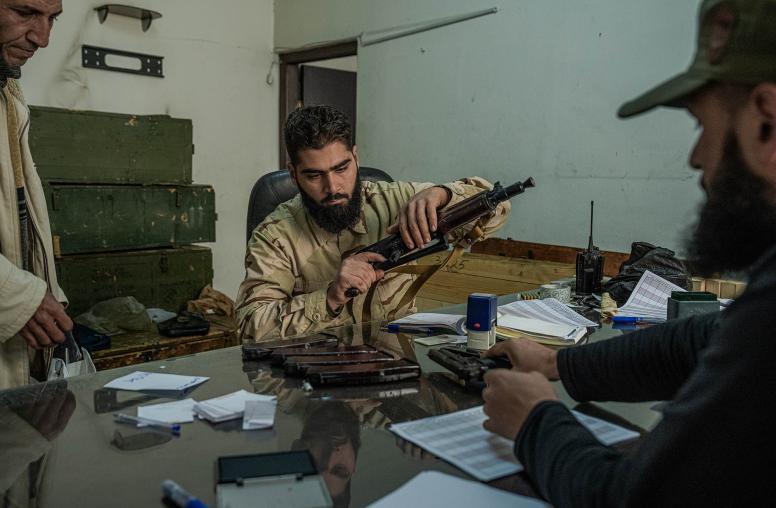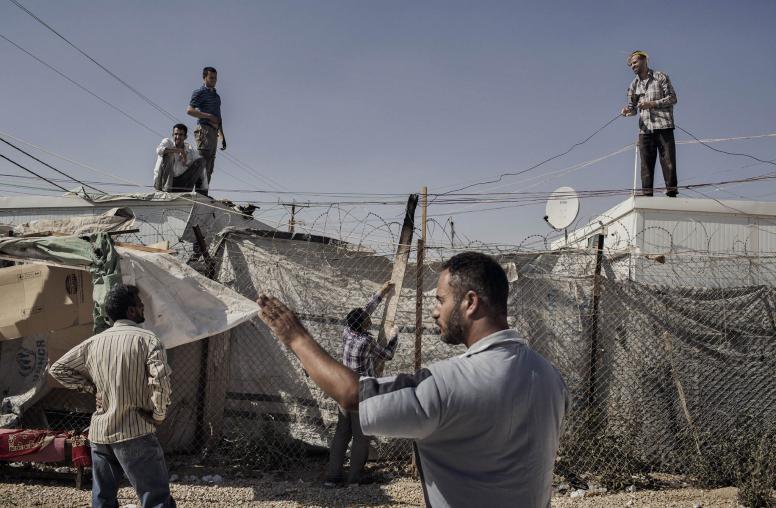Al-Hol: Displacement Crisis is a Tinderbox that Could Ignite ISIS 2.0
Growing concern over the dire conditions in the camp has galvanized high-level global attention to detention and displacement in northeast Syria.
More than three years after ISIS’s territorial defeat, the vexing challenge of displacement threatens to provoke the rise of ISIS 2.0 if not adequately addressed. The May 11 Global Coalition to Defeat ISIS ministerial meeting in Marrakech, Morocco highlights these concerns over the evolving threat the so-called Islamic State still poses. The Marrakech meeting coincides with both growing disquiet at deteriorating humanitarian and security conditions in the al-Hol displacement camp in northeast Syria — ground zero for the ISIS-related displacement crisis — and some hope for a path forward.

ISIS Prison Break Is Clarion Call to Action
This past January, a 10-day battle over the Al-Sina’a prison in Hasakeh, Syria — one of 27 ISIS detention sites guarded by the Kurdish-led Syrian Democratic Forces (SDF) — crystallized fears of an ISIS resurgence. ISIS militants launched the attack in the hopes of freeing ISIS fighters. An estimated 500 people were killed, including detainees, prison staff and civilians. An unknown number of ISIS fighters escaped. The attack was the most sophisticated ISIS operation since its 2019 defeat, requiring the assistance of U.S. forces to finally quell the violence.
The January prison break has served as a clarion call to action. Citing the January attack, humanitarian organizations and other stakeholders have raised alarms about the deteriorating situation in the prisons and displacement camps, underscoring that the current situation is unsustainable. They have renewed calls for the international community to address the twin challenges of ISIS detention comprising some 12,000 suspected fighters and the ISIS-related displacement of some 60,000 women and children with perceived ISIS affiliation, currently residing in displacement camps in northeast Syria.
Al-Hol Camp at the Center of the Displacement Crisis
By far the largest displacement camp, al-Hol houses around 56,000 people, predominantly women and children, with an estimated 70 percent of the population under age 18 and a significant proportion under age 12. While the camp dates to 1991 when it received Iraqi refugees from the first Gulf War, its population swelled from 10,000 in 2018 to nearly 75,000 as women and children streamed out of the last ISIS stronghold in Baghouz, Syria. The camp’s population is roughly divided into Iraqis (48%), Syrians (37%) and foreigners from 60 countries (15%).
Al-Hol embodies the many complexities associated with ISIS-related displacement. Beyond the clear concerns regarding the children whose protection is required under international humanitarian law, the women in the camp include victims, bystanders and perpetrators of extremist violence under ISIS. Some of the camp’s women have played the role of enforcers, perpetuating ISIS’s extremist ideology and norms by meting out harsh punishment, including death, to those women who do not obey. Other women have suffered significant trauma both inside the camp and under ISIS rule while living in the so-called “caliphate.”
Acute Humanitarian and Security Crises Plague the Camp
Deteriorating security and humanitarian conditions plague the camp and are leading to an acute crisis. Since early 2022, security incidents have escalated. On March 28, ISIS militants inside the camp attacked camp security using rocket-propelled grenades and small arms, leaving four dead. Subsequently, ISIS spokesman Abu Omar al-Muhajir threatened further attacks including on al-Hol in an April 17 audio statement. ISIS has reportedly undertaken at least 20 attacks in eastern Syria since the statement including a high-profile attack on a Ramadan gathering in late April.
Compounded by the COVID-19 pandemic, economic collapse across Syria, and global food and fuel price hikes in the wake of the Ukraine conflict, humanitarian conditions in the camp have plummeted, with inadequate medical facilities, irregular provision of water and insufficient sanitation. Security conditions at times also lead to temporary lockdowns when no assistance can be delivered to camp residents. Such conditions are particularly concerning for the camp’s many children who lack sufficient health care or education; many are traumatized by violence within the camp.
Window of Opportunity?
The January 2022 al-Sina’a prison break appears to have galvanized high-level global attention around the deepening crisis of ISIS detention and displacement in northeast Syria, potentially creating an opportunity to forge a path forward on the displacement challenge. In his first trip to the region as the new commander of U.S. Central Command, General Michael “Erik” Kurilla visited the al-Hol camp, the most senior U.S. official to tour the facility. General Kurilla’s stop at al-Hol underscores the United States government’s mounting concerns regarding the camp and its potential to spawn a new generation of extremists if overlapping humanitarian and security crises go unaddressed.
Equally significant, the Iraqi government has called for the al-Hol camp to be closed and its residents repatriated to their countries of origin, citing mounting security concerns. Baghdad has elevated the importance of addressing the challenge of ISIS-related displacement, with the national security advisor’s office now playing a greater role in addressing the challenge of repatriating the 30,000 Iraqi nationals in the camp. Yet, to date, only 450 of the more than 8,000 Iraqi families in al-Hol have been transferred to Iraq.
Syrian residents of the camp are considered internally displaced with different circumstances depending on where in Syria they come from. Those hailing from area of northeast Syria under Kurdish control are returned through a process of tribal sponsorship where local tribes submit their names to the Kurdish authorities running the camp. They are vetted and allowed to return with local tribal heads serving as guarantors. Meanwhile, Syrian camp residents who are from regime-held areas, Turkish-controlled zones or Idlib — an area of northwest Syria under the control of Hayat Tahrir al-Sham — face significant obstacles to return. There is no channel or mechanism to facilitate Kurdish engagement with authorities in control of these different areas, rendering formal returns virtually impossible.
While the obstacles for Iraqi repatriation are significant (including, among other things, the need to form a government), Iraq’s evident willingness to confront the al-Hol challenge could represent an important opportunity to make some headway on repatriating the camp’s Iraqi residents. As a first step, a coordinated international effort to facilitate case management and vetting of the camp’s residents could bring much needed clarity to camp residents on their status and prospects for repatriation. Humanitarian workers cite residents’ hopelessness and uncertainty over their future as a driver of extremism and violence in the camp. Given Iraq’s potential interest in repatriating eligible Iraqis and ongoing efforts to return Syrians, enhanced case management and vetting mechanism could first be deployed among the camp’s Iraqi and Syrian residents to facilitate their return.
More work is also needed to prepare Iraqi and Syrian communities for the eventual return of families from al-Hol. In Iraq, even if cleared for return to their areas of origin, families with perceived ISIS affiliation often fear that they will be subject to revenge acts of violence from ISIS victims’ families. Preparing the ground for their return by addressing tensions between receiving communities and returning families will be essential. Ensuring government compensation and livelihoods support to ISIS victims’ families as well as broader efforts to restore social cohesion and address stigmatization of families with perceived ISIS affiliations will be essential to achieving the sustained return and reintegration of Iraqi families from al-Hol. Similarly, in Syria, addressing both social cohesion challenges and the impacts of the country’s steep economic decline as well as ensuring that communities are equipped to handle rehabilitation and reintegration needs are critical elements for success.
The Marrakech ministerial provides a timely opportunity for the Global Coalition to engage on the multi-faceted challenge of displacement in the wake of ISIS’s fall. A concerted, coordinated international effort to address the interlocking humanitarian and security issues in the al-Hol camp is needed. In addition, the international community should devote more attention and resources to preparing communities for the return of displaced families. Taken together, these initiatives could help prevent the next generation of ISIS from emerging out of the chaos of al-Hol.


